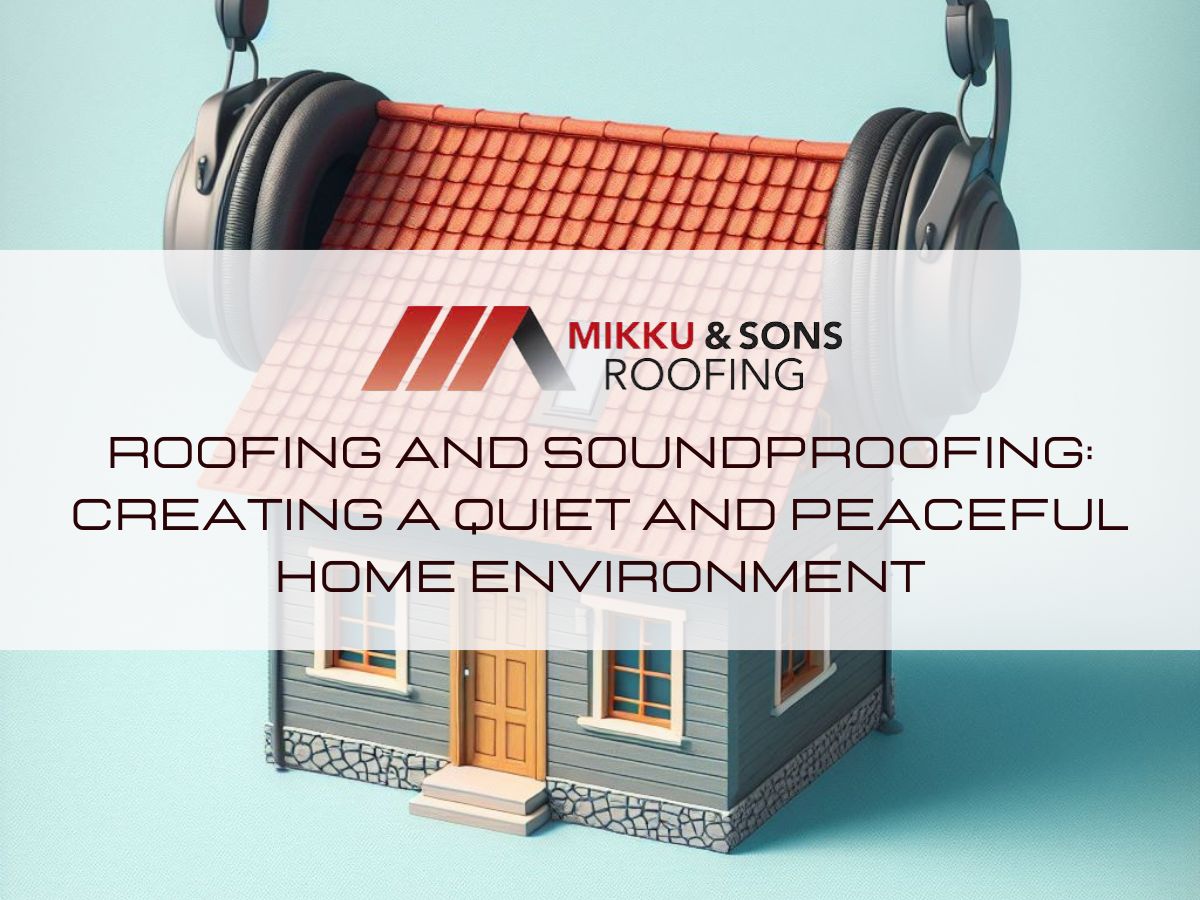

Creating a quiet and peaceful home environment is essential for comfort and well-being, particularly in bustling urban areas where noise pollution can be a significant issue. Effective roofing and soundproofing techniques are vital in achieving this tranquility. By implementing various soundproofing strategies, such as insulation, soundproof underlayment, and green roofs, homeowners can significantly reduce external noise infiltration.
These solutions not only enhance the acoustic comfort of a home but also offer additional benefits like improved energy efficiency and increased property value. This guide explores the key considerations and techniques for soundproofing your roof, ensuring a serene living space. Let's look at roofing and soundproofing.
Soundproofing a roof is essential for creating a tranquil living environment, especially in areas prone to noise pollution from traffic, airplanes, or other external sources. Effective soundproofing not only enhances comfort but also improves the overall quality of life. Here, we will delve into various soundproofing techniques for roofs, exploring their benefits and how they contribute to a quieter home.
Insulation is one of the most fundamental techniques for soundproofing a roof. Materials like mineral wool, foam boards, and fiberglass are commonly used due to their excellent sound-absorbing properties. These materials work by absorbing sound vibrations and preventing them from traveling through the roof structure.Below are types of Insulation:
Insulating your roof not only reduces noise pollution but also improves energy efficiency, leading to lower heating and cooling costs. Additionally, insulation can enhance the overall structural integrity of the roof, providing long-term benefits.
Soundproof underlayment is another effective method to reduce noise, particularly impact noise caused by rain, hail, or footsteps. This technique involves placing a layer of material between the roof deck and the roofing material. Below are types of soundproof underlayment:
Soundproof underlayment helps in dissipating sound waves, reducing the noise that enters the building. It also provides additional insulation, contributing to a more energy-efficient home. This technique is especially useful for metal roofs, which can be particularly noisy during rainstorms.
Green roofs, also known as living roofs, involve the use of vegetation and soil layers on top of the roof structure. This not only enhances the aesthetic appeal of a building but also provides natural sound insulation.Below are components of green roofs:
Green roofs offer multiple benefits, including improved thermal insulation, reduced urban heat island effect, and enhanced biodiversity. They also contribute to better air quality and stormwater management. From a soundproofing perspective, green roofs are highly effective in reducing noise pollution, making them an eco-friendly and practical solution.
Acoustic panels are specifically designed to control sound reflections within a space. While they are more commonly used in interiors, they can also be applied to roof structures to enhance soundproofing.Below are types of acoustic panels:
Acoustic panels are a cost-effective solution for improving the acoustics of a space. They are easy to install and can be customized to fit the aesthetic of the building. By reducing internal noise reflections, acoustic panels contribute to a more comfortable and pleasant living environment.
Sometimes, noise problems can be traced back to structural issues within the roof. Fixing these problems can significantly reduce noise at its source. Below are common structural issues:
Addressing structural issues not only reduces noise but also extends the lifespan of the roof. Regular maintenance and timely repairs prevent minor problems from escalating into major issues, saving homeowners time and money in the long run.
Effective roof soundproofing offers numerous advantages beyond just noise reduction. It enhances the overall living experience, providing a peaceful and comfortable environment. Here are some of the key benefits:
Soundproofing significantly reduces the amount of external noise that enters the home. This is particularly beneficial for homes located near busy roads, airports, or industrial areas. A quieter home environment promotes better sleep, reduces stress levels, and enhances overall well-being.
Effective soundproofing improves the acoustics within a home. It minimizes echo and reverberation, making it easier to communicate and enjoy media such as music and movies. This is especially important for homes with open floor plans or high ceilings.
Soundproofing helps in maintaining privacy by preventing sounds from escaping the building. This is beneficial in densely populated areas where houses are close together. It ensures that conversations and activities inside the home remain private.
A well-soundproofed home is more comfortable to live in. It provides a serene environment free from the disruptions of external noise. This contributes to a higher quality of life and makes the home a more enjoyable place to be.
Homes with effective soundproofing are often more desirable to potential buyers. They offer a better living experience, which can translate into a higher property value. Soundproofing can be seen as an investment that enhances the overall appeal and marketability of a home.
Soundproofing a roof is a significant investment that can dramatically improve the quality of life within your home. However, there are several important considerations homeowners should keep in mind before embarking on this project.
Evaluating the existing roof structure, consulting professionals, balancing cost-effectiveness with long-term benefits, and prioritizing multi-functional solutions are key steps to ensure a successful soundproofing endeavor.
Before implementing any soundproofing techniques, it’s essential to thoroughly evaluate the existing roof structure. Identifying problem areas where noise infiltration is most prominent will help you target your efforts more effectively.
Common issues may include gaps, cracks, loose shingles, or faulty joints that allow sound to penetrate. A detailed inspection can reveal these weak points, enabling you to address them directly and improve the overall soundproofing performance of your roof.
While DIY solutions may seem tempting, consulting with professionals is highly recommended for the installation of soundproofing materials. Experienced contractors have the expertise to choose the right materials and apply them correctly, ensuring maximum effectiveness.
Professionals can also provide valuable insights into the most suitable soundproofing techniques for your specific roof type and local environmental conditions. Their guidance can help prevent common pitfalls and ensure a smoother, more efficient installation process.
When planning your soundproofing project, it’s crucial to balance cost-effectiveness with long-term benefits. While some materials and techniques may have a higher upfront cost, they often provide superior performance and durability, leading to greater long-term savings.
For example, investing in high-quality insulation or mass-loaded vinyl may be more expensive initially, but these materials offer exceptional soundproofing and can also improve energy efficiency, reducing heating and cooling costs over time. Conducting a cost-benefit analysis can help you make informed decisions that align with your budget and future goals.
To maximize the return on your investment, prioritize soundproofing solutions that offer multiple advantages. For instance, insulation not only absorbs sound but also enhances thermal efficiency, contributing to lower energy bills and a more comfortable home environment.
Similarly, green roofs provide natural sound insulation while also offering aesthetic and environmental benefits, such as improved air quality and reduced urban heat island effect. By choosing solutions that address multiple needs, you can achieve greater overall value and functionality.
Beyond these primary considerations, there are a few additional factors homeowners should keep in mind.
Investing in soundproofing your roof is a strategic approach to cultivating a serene and comfortable home environment. By evaluating your existing roof structure, consulting professionals, and selecting multi-functional soundproofing solutions, you can effectively mitigate noise pollution.
These efforts not only enhance your daily living experience but also contribute to the overall value and efficiency of your home. Whether through insulation, soundproof underlayment, or green roofs, the benefits of a soundproofed roof extend beyond noise reduction, providing long-term advantages for homeowners. Embrace these techniques to transform your home into a peaceful sanctuary.
